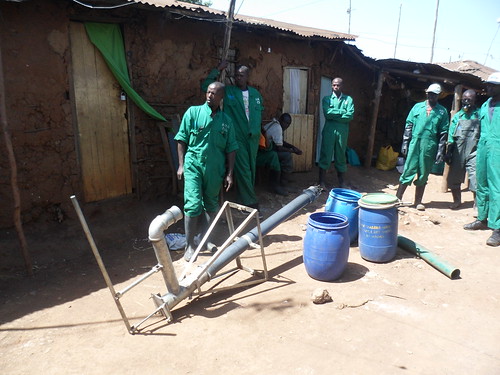- Sanitation systems
- Faecal sludge management (FSM)
- Faecal sludge transport (including emptying of pits and septic tanks, transfer stations)
- Pit emptying (Gulper and others)
Pit emptying (Gulper and others)
30.4k views
- Elisabeth
-
- Moderator
- Freelance consultant since 2012 (former roles: program manager at GIZ and SuSanA secretariat, lecturer, process engineer for wastewater treatment plants)
Less- Posts: 3372
- Karma: 54
- Likes received: 931
Re: Captiva Africa-Water for People Launch Gulper Technology
For those who have been "watching this space" since Dave's last post on 19 March 2013 (scrol up), the test results are now available here on the forum:
forum.susana.org/forum/categories/99-fae...nd-south-africa#4254
(please continue the discussion there)
It's about the work of Tate Rogers and others from North Carolina State University who have tested their hydraulically powered auger to empty pit latrines near Pietermaritzburg in South Africa.
forum.susana.org/forum/categories/99-fae...nd-south-africa#4254
(please continue the discussion there)
It's about the work of Tate Rogers and others from North Carolina State University who have tested their hydraulically powered auger to empty pit latrines near Pietermaritzburg in South Africa.
Dr. Elisabeth von Muench
Freelance consultant on environmental and climate projects
Freelance consultant on environmental and climate projects
The following user(s) like this post: Doreen
Please Log in to join the conversation.
You need to login to reply
Hi Steve
Tate Rogers and Walt Beckwith arrived late last night. Today they have assembled and tested the auger on our pig slurry in the yard. Tomorrow they will start with pour flush pits, which I expect they will manage easily. The only thing to check will be to what extent the sludge flows to the auger and to what extent the auger has to be manhandled around. Then later tomorrow and Thursday they move on to VIPs or increasing difficulty.
Their machine is very professionally made. The hydraulic drive is a great idea, as it keeps the auger weight down. They also have plastic auger flights, which are off the shelf items where they come from.
Watch this space!
Dave
Tate Rogers and Walt Beckwith arrived late last night. Today they have assembled and tested the auger on our pig slurry in the yard. Tomorrow they will start with pour flush pits, which I expect they will manage easily. The only thing to check will be to what extent the sludge flows to the auger and to what extent the auger has to be manhandled around. Then later tomorrow and Thursday they move on to VIPs or increasing difficulty.
Their machine is very professionally made. The hydraulic drive is a great idea, as it keeps the auger weight down. They also have plastic auger flights, which are off the shelf items where they come from.
Watch this space!
Dave
Regards
Dave
Dave
Attachments:
-
March182013112.JPG (Filesize: 65KB)
Please Log in to join the conversation.
You need to login to reply- stevensugden
-
 Topic AuthorLess
Topic AuthorLess- Posts: 32
- Karma: 8
- Likes received: 28
- Mana
-

- I am Manaye Siyoum Tariku. I have Bsc in Environmental and MSC in public health. I have more than 14 years experience in WASH and other public health intervention. Currently I am working WaterAid Ethiopia as Urban WASH program manager and previously I hav
Less- Posts: 2
- Likes received: 0
{Note by moderator: This post with its question fits better to this current thread than a stand alone thread. Moved on 18 March 2013, please feel free to answer Mana question. TMS}
We have a plan to test small scale pit emptying using machines by Micro and small enterprises but we do not have the experience here in Ethiopia. I need document as well technical support to start the program
We have a plan to test small scale pit emptying using machines by Micro and small enterprises but we do not have the experience here in Ethiopia. I need document as well technical support to start the program
Please Log in to join the conversation.
You need to login to reply
Tate Rogers and a colleague from North Carolina State University will be testing their hydraulically powered auger near Pietermaritburg in two weeks' time.
For a video of their auger working with pig slurry, here's a link.
"A quick description of the video: We are using a gasoline (petrol) engine to run a hydraulic motor that rotates the auger at speeds up to 400 rpm. We currently have 25 ft (7.5m) hydraulic hoses so the gasoline engine (which is on wheels) only needs to be within 25 of the pit. It is equipped with a reverse that makes unjamming easier in addition to emptying most of the waste from the pipe upon finishing. We are pumping from a 1.2 m^3 container and lifting the material 8.5 ft (2.6 m). At the farm we were obtaining flow rates between 90 and 125 liters per minute until the very bottom of the tote was reached."
We'll post some video clips and notes on how the field testing has gone when it's done.
For a video of their auger working with pig slurry, here's a link.
"A quick description of the video: We are using a gasoline (petrol) engine to run a hydraulic motor that rotates the auger at speeds up to 400 rpm. We currently have 25 ft (7.5m) hydraulic hoses so the gasoline engine (which is on wheels) only needs to be within 25 of the pit. It is equipped with a reverse that makes unjamming easier in addition to emptying most of the waste from the pipe upon finishing. We are pumping from a 1.2 m^3 container and lifting the material 8.5 ft (2.6 m). At the farm we were obtaining flow rates between 90 and 125 liters per minute until the very bottom of the tote was reached."
We'll post some video clips and notes on how the field testing has gone when it's done.
Regards
Dave
Dave
Please Log in to join the conversation.
You need to login to reply- stevensugden
-
 Topic AuthorLess
Topic AuthorLess- Posts: 32
- Karma: 8
- Likes received: 28
The extended gulper has been used for a couple of months and has run into problems. The plastic pipe no longer freely extends as it has become blocked with grit and shit. Otherwise the operator, Sam, likes the device and particularly how easy it is to pump compared to the normal Gulper. He reports that it is good for removing thick sludge whatever that is)
vimeo.com/59891397
PS - we really do need a better way of classifying sludge. Jamie Radford's work is a great starting point for this.
vimeo.com/59891397
PS - we really do need a better way of classifying sludge. Jamie Radford's work is a great starting point for this.
Please Log in to join the conversation.
You need to login to reply- stevensugden
-
 Topic AuthorLess
Topic AuthorLess- Posts: 32
- Karma: 8
- Likes received: 28
I see the emptiers in Kenya are still using the long Gulper. Have they developed a better way of emptying it and fitting it in to the super structure yet?
Here are a couple of links for the video showing our work in Kampala.
The first show a $800 locally available Chinese petrol driven pump - it struggles with thicker sludge, but its better than a normal centrifuge pump.
And the second show the rubbish and the nature of the sludge the emptiers are having to deal with.
Enjoy
S
Here are a couple of links for the video showing our work in Kampala.
The first show a $800 locally available Chinese petrol driven pump - it struggles with thicker sludge, but its better than a normal centrifuge pump.
And the second show the rubbish and the nature of the sludge the emptiers are having to deal with.
Enjoy
S
Please Log in to join the conversation.
You need to login to reply
In addition, I would like to point out that Elisabeth uploaded some documents in the SuSanA library called Tackling the challenges of full pit latrines, Volume 1-3. Volume3 particularly looks into pit emptying technologies.
The link to the document is here: www.susana.org/lang-en/library?view=ccbktypeitem&type=2&id=1712
Bibliographic information:
Still, D., Foxon, K., O’Riordan, M. (2012). Tackling the challenges of full pit latrines -Volumes 1 to 3. WRC Report No. 1745/1/12, Water Research Commission, South Africa.
A bit more information here about the volumes:
+++++++++++++
Volume 1: Understanding sludge accumulation in VIPs and strategies for emptying full pits
The task of providing adequate sanitation does not end with building toilets. On-site systems will eventually reach capacity and if a long-term plan for their maintenance, supported by a budget, is not in place, full toilets will become unusable and households will be effectively without basic sanitation once again. Water Services Authorities need urgently to assess the real requirements of the basic sanitation systems they have delivered and put plans, policies and budgets in place to maintain these systems if they are to avoid a sanitation crisis in the near future.
To date, additives currently being marketed to reduce pit filling have proven ineffective. While thepotential for significantly enhancing processes already occurring in the pit seems limited, there is a need
for standard methods to be established in order to investigate the effectiveness of new products. In the absence of this, municipal funds are better invested in proven methods of sludge removal.
The experience of municipalities, such as eThekwini, which have led the way in pit emptying has demonstrated that vacuum tankers are not always effective for maintaining VIP systems. The development of more appropriate technologies shows promise and prototypes designed during this research provide a strong basis for further development.
The presence of waste in the pits of toilets represents an enormous obstacle to effective pit emptying. Placing a high priority on instituting and maintaining reliable solid waste collection programmes will go a long way to solving this problem.
Sludge removed from a pit represents a resource, in terms of its nutrient content. Every effort should be made to utilise it beneficially rather dispose of it as a waste.
++++++++++++
Volume 2: How fast do pit toilets fill up? A scientific understanding of sludge build up and accumulation in pit latrines
Previous studies of on-site systems indicate a wide range of accumulation rates for wet (septic tank) systems (22 ℓ/c.a to 95 ℓ/c.a) as well as for pit latrines (19 ℓ/c.a to 70 ℓ/c.a). Filling rates for pit latrines observed in this study ranged from 21 ℓ/c.a to 64 ℓ/c.a. It was found that pits typically filled at a rate ranging from 200 ℓ/annum to 500 ℓ/annum regardless of the number of users. For pit design, using a figure of 40 ℓ/c.a meets household requirements, while basing pit emptying programmes on a figure of 60 ℓ/c.a ensures that pits do not reach capacity before the commencement of the planned emptying cycle.
Some municipalities have turned to products marketed to slow or halt accumulation in the pit in the hope that this will significantly reduce the frequency at which they will need to be serviced or eliminate
the need altogether. In order to investigate the efficacy of these products, the Water Research Commission has tested approximately 20 pit additives in field and laboratory trials. To date none have been found to be effective in reducing pit filling rates. It is vital that municipalities do not spend their sanitation budgets on products with no proven benefit, leaving inadequate funds to service their onsite
sanitation systems with tried and tested methods when these products fail.
Few municipalities have been proactive to date in terms of developing sanitation management programmes which integrate pit design and pit maintenance and where pit filling is monitored. As a result, many are likely to face a critical situation in the near future when pits reach capacity and they are ill prepared to respond. It is imperative that municipalities put programmes in place which are based on a sound understanding of the behaviour of users, geophysical characteristics of the area and system design so that they can manage the maintenance of systems efficiently and without compromising public health.
+++++++++++++++++
Volume 3: The development of pit emptying technologies
This report presents the design, development and testing of a number of prototypes of portable pit emptying technologies that were developed as part of Water Research Commission research project K5/1745.
The designs which have been explored to date have been the pit screw auger, which uses a motorised soil auger to lift sludge from a pit, the Nano Vac and e Vac, which use piston pumps and vane pumps to suck relatively wet sludge from pits. In addition, a pressure vessel has been
developed which can be used for collecting sludge or for pumping water or air into a pit to aid removal.
Being portable by two people these technologies do overcome the issue of access and have proven viable when trialled on pig slurry. The eVac has in addition been used successfully to empty wettish pit latrines in the field, which it does with little difficulty. Being the most robust and the most compact of the devices, the eVac appears to have the most potential on pit latrines in the field, and should be the focus for further research and development work.
++++++++++
Best regards,
Doreen
The link to the document is here: www.susana.org/lang-en/library?view=ccbktypeitem&type=2&id=1712
Bibliographic information:
Still, D., Foxon, K., O’Riordan, M. (2012). Tackling the challenges of full pit latrines -Volumes 1 to 3. WRC Report No. 1745/1/12, Water Research Commission, South Africa.
A bit more information here about the volumes:
+++++++++++++
Volume 1: Understanding sludge accumulation in VIPs and strategies for emptying full pits
The task of providing adequate sanitation does not end with building toilets. On-site systems will eventually reach capacity and if a long-term plan for their maintenance, supported by a budget, is not in place, full toilets will become unusable and households will be effectively without basic sanitation once again. Water Services Authorities need urgently to assess the real requirements of the basic sanitation systems they have delivered and put plans, policies and budgets in place to maintain these systems if they are to avoid a sanitation crisis in the near future.
To date, additives currently being marketed to reduce pit filling have proven ineffective. While thepotential for significantly enhancing processes already occurring in the pit seems limited, there is a need
for standard methods to be established in order to investigate the effectiveness of new products. In the absence of this, municipal funds are better invested in proven methods of sludge removal.
The experience of municipalities, such as eThekwini, which have led the way in pit emptying has demonstrated that vacuum tankers are not always effective for maintaining VIP systems. The development of more appropriate technologies shows promise and prototypes designed during this research provide a strong basis for further development.
The presence of waste in the pits of toilets represents an enormous obstacle to effective pit emptying. Placing a high priority on instituting and maintaining reliable solid waste collection programmes will go a long way to solving this problem.
Sludge removed from a pit represents a resource, in terms of its nutrient content. Every effort should be made to utilise it beneficially rather dispose of it as a waste.
++++++++++++
Volume 2: How fast do pit toilets fill up? A scientific understanding of sludge build up and accumulation in pit latrines
Previous studies of on-site systems indicate a wide range of accumulation rates for wet (septic tank) systems (22 ℓ/c.a to 95 ℓ/c.a) as well as for pit latrines (19 ℓ/c.a to 70 ℓ/c.a). Filling rates for pit latrines observed in this study ranged from 21 ℓ/c.a to 64 ℓ/c.a. It was found that pits typically filled at a rate ranging from 200 ℓ/annum to 500 ℓ/annum regardless of the number of users. For pit design, using a figure of 40 ℓ/c.a meets household requirements, while basing pit emptying programmes on a figure of 60 ℓ/c.a ensures that pits do not reach capacity before the commencement of the planned emptying cycle.
Some municipalities have turned to products marketed to slow or halt accumulation in the pit in the hope that this will significantly reduce the frequency at which they will need to be serviced or eliminate
the need altogether. In order to investigate the efficacy of these products, the Water Research Commission has tested approximately 20 pit additives in field and laboratory trials. To date none have been found to be effective in reducing pit filling rates. It is vital that municipalities do not spend their sanitation budgets on products with no proven benefit, leaving inadequate funds to service their onsite
sanitation systems with tried and tested methods when these products fail.
Few municipalities have been proactive to date in terms of developing sanitation management programmes which integrate pit design and pit maintenance and where pit filling is monitored. As a result, many are likely to face a critical situation in the near future when pits reach capacity and they are ill prepared to respond. It is imperative that municipalities put programmes in place which are based on a sound understanding of the behaviour of users, geophysical characteristics of the area and system design so that they can manage the maintenance of systems efficiently and without compromising public health.
+++++++++++++++++
Volume 3: The development of pit emptying technologies
This report presents the design, development and testing of a number of prototypes of portable pit emptying technologies that were developed as part of Water Research Commission research project K5/1745.
The designs which have been explored to date have been the pit screw auger, which uses a motorised soil auger to lift sludge from a pit, the Nano Vac and e Vac, which use piston pumps and vane pumps to suck relatively wet sludge from pits. In addition, a pressure vessel has been
developed which can be used for collecting sludge or for pumping water or air into a pit to aid removal.
Being portable by two people these technologies do overcome the issue of access and have proven viable when trialled on pig slurry. The eVac has in addition been used successfully to empty wettish pit latrines in the field, which it does with little difficulty. Being the most robust and the most compact of the devices, the eVac appears to have the most potential on pit latrines in the field, and should be the focus for further research and development work.
++++++++++
Best regards,
Doreen
Doreen Mbalo
GIZ Sustainable Sanitation Programme
Policy Advisor in Bonn, Germany
Deutsche Gesellschaft für Internationale Zusammenarbeit (GIZ) GmbH
E This email address is being protected from spambots. You need JavaScript enabled to view it.
GIZ Sustainable Sanitation Programme
Policy Advisor in Bonn, Germany
Deutsche Gesellschaft für Internationale Zusammenarbeit (GIZ) GmbH
E This email address is being protected from spambots. You need JavaScript enabled to view it.
The following user(s) like this post: Elisabeth
Please Log in to join the conversation.
You need to login to reply
Dear Steve,
I enjoyed reading your paper and passed it on to some of my colleagues here in Kenya. Thanks a lot! It was very interesting. You are right to say that not enough is being discussed in the forum regarding pit emptying albeit having an FSM category in the forum here: forum.susana.org/forum/categories/53-faecal-sludge-management
However I would like to draw you attention to the following post within the discussion forum on pit emptying.
forum.susana.org/forum/categories/53-fae...-exhauster-operators
Below are also some pictures that I took that could be useful:
Exhauster Operators: www.flickr.com/photos/gtzecosan/sets/72157629204908188/
Gulper: www.flickr.com/photos/gtzecosan/sets/72157629487403117/
Manual emptiers: www.flickr.com/photos/gtzecosan/sets/72157629202806662/
By the way your quote from Paul Polak in the paper really hit home and I believe this is something that many organisations involved in sanitation have still not fully grasped… that the majority of the solution lies in designing an effective marketing, distribution and profitable business strategy that can be brought to scale.
I urge other FSM focussed colleagues to contribute their experiences, feedback, suggestions and pictures in the forum. In addition, thank you for the video showing the latest prototype. Any chance we shall be able to try it out here in Kenya? maybe the Kara Group based in Kibera?
Best regards,
Doreen
I enjoyed reading your paper and passed it on to some of my colleagues here in Kenya. Thanks a lot! It was very interesting. You are right to say that not enough is being discussed in the forum regarding pit emptying albeit having an FSM category in the forum here: forum.susana.org/forum/categories/53-faecal-sludge-management
However I would like to draw you attention to the following post within the discussion forum on pit emptying.
forum.susana.org/forum/categories/53-fae...-exhauster-operators
Below are also some pictures that I took that could be useful:
Exhauster Operators: www.flickr.com/photos/gtzecosan/sets/72157629204908188/
Gulper: www.flickr.com/photos/gtzecosan/sets/72157629487403117/
Manual emptiers: www.flickr.com/photos/gtzecosan/sets/72157629202806662/
By the way your quote from Paul Polak in the paper really hit home and I believe this is something that many organisations involved in sanitation have still not fully grasped… that the majority of the solution lies in designing an effective marketing, distribution and profitable business strategy that can be brought to scale.
I urge other FSM focussed colleagues to contribute their experiences, feedback, suggestions and pictures in the forum. In addition, thank you for the video showing the latest prototype. Any chance we shall be able to try it out here in Kenya? maybe the Kara Group based in Kibera?
Best regards,
Doreen
Doreen Mbalo
GIZ Sustainable Sanitation Programme
Policy Advisor in Bonn, Germany
Deutsche Gesellschaft für Internationale Zusammenarbeit (GIZ) GmbH
E This email address is being protected from spambots. You need JavaScript enabled to view it.
GIZ Sustainable Sanitation Programme
Policy Advisor in Bonn, Germany
Deutsche Gesellschaft für Internationale Zusammenarbeit (GIZ) GmbH
E This email address is being protected from spambots. You need JavaScript enabled to view it.
Please Log in to join the conversation.
You need to login to reply- CAGIEA
-
 Less
Less- Posts: 29
- Likes received: 4
Dear Muench
Thanks for the information, I had already seen the postings by Doreen Mbalo about pit emptying in Kenya and even contacted her on the same. I only thought that Steve had some new technology.
Regards
Deo
Thanks for the information, I had already seen the postings by Doreen Mbalo about pit emptying in Kenya and even contacted her on the same. I only thought that Steve had some new technology.
Regards
Deo
Please Log in to join the conversation.
You need to login to reply- stevensugden
-
 Topic AuthorLess
Topic AuthorLess- Posts: 32
- Karma: 8
- Likes received: 28
- Elisabeth
-
- Moderator
- Freelance consultant since 2012 (former roles: program manager at GIZ and SuSanA secretariat, lecturer, process engineer for wastewater treatment plants)
Less- Posts: 3372
- Karma: 54
- Likes received: 931
Re: Pit emptying
Dear Deo and Steve,
(I have just fixed the file attachment problem, please see above; Steve is this the paper you wanted to attach?)
Dear Steve, welcome to the forum! You are well known in the sector, but could you nevertheless please give a 1-2 sentence introduction about yourself in your first posting (you can go back and edit it), if you don't mind? That would be great. Feel free to provide the website of your organisation as well.
I was fortunate to be able to listen to Steve's keynote at the recent Durban Faecal Sludge Management conference live. Everyone else will be able to see it on the video recording which was taken of all the presentations and which will be uploaded to the SuSanA Youtube channel hopefully within the next 2-3 weeks (WRC will make the discs available to the SuSanA secretariat). Also the presentations and papers will be available on the SuSanA website very soon.
Steve's presentation was very interesting and memorable, not only because of the dry humour which most Brits seem to have and use so successfully! (photo of Steve with his thinking cap on which consists of frozen sausages...).
(photo of Steve with his thinking cap on which consists of frozen sausages...).
Some take away notes that I made for myself:
++++++++++++
There are two types of pit emptiers:
Get entrepreneurs interested in sanitation - instead of focussing on getting sanitation people interested in business.
The longest part of the process of pit emptying is transporting it to the dump site (remember traffic jams in big cities!). Thus a device that allows for faster pit emptying may not make much difference.
Develop pit emptying technologies that complement business models (ask yourself "who would buy the Gulper?").
Masons, bloody masons (can't work with them, can't work without them).
--> Deskill latrine building so that you don't need masons; build latrines by technicians not by masons; they are easier to replace if needed.
++++++++++++
If you want to know more about Steve's ideas, do read the paper which is attached to his post. And please discuss it here if you have comments or remarks.
Steve mentioned that we don't have much about pit emptying on the SuSanA platform yet. I agree with him, although we have increased the content in recent times. In the SuSanA library there is a category on FSM which you can select on the right hand side.
See here the direct link:
www.susana.org/lang-en/library?showby=ye...s=7&vbl_7=78&vbl_0=0
(it shows 40 documents; the secretariat will add the ones from FSM-2).
And of course we have in the forum here the category on FSM which has quite some vibrant discussions on FSM topics already (see in particular the excellent postings by Doreen Mbalo about pit emptying in Kenya). Here I have added one of her photos just as an eye catcher, more photos are available in that same set on flickr, just click on the link below the photo:

SAM_2209 by Sustainable sanitation , on Flickr
Regards,
Elisabeth
(I have just fixed the file attachment problem, please see above; Steve is this the paper you wanted to attach?)
Dear Steve, welcome to the forum! You are well known in the sector, but could you nevertheless please give a 1-2 sentence introduction about yourself in your first posting (you can go back and edit it), if you don't mind? That would be great. Feel free to provide the website of your organisation as well.
I was fortunate to be able to listen to Steve's keynote at the recent Durban Faecal Sludge Management conference live. Everyone else will be able to see it on the video recording which was taken of all the presentations and which will be uploaded to the SuSanA Youtube channel hopefully within the next 2-3 weeks (WRC will make the discs available to the SuSanA secretariat). Also the presentations and papers will be available on the SuSanA website very soon.
Steve's presentation was very interesting and memorable, not only because of the dry humour which most Brits seem to have and use so successfully!
Some take away notes that I made for myself:
++++++++++++
There are two types of pit emptiers:
- those who have to empty pits
- those who want to empty pits (and it is in their interest to keep the work disgusting to prevent new entrants into the business and to charge a premium!).
Get entrepreneurs interested in sanitation - instead of focussing on getting sanitation people interested in business.
The longest part of the process of pit emptying is transporting it to the dump site (remember traffic jams in big cities!). Thus a device that allows for faster pit emptying may not make much difference.
Develop pit emptying technologies that complement business models (ask yourself "who would buy the Gulper?").
Masons, bloody masons (can't work with them, can't work without them).
--> Deskill latrine building so that you don't need masons; build latrines by technicians not by masons; they are easier to replace if needed.
++++++++++++
If you want to know more about Steve's ideas, do read the paper which is attached to his post. And please discuss it here if you have comments or remarks.
Steve mentioned that we don't have much about pit emptying on the SuSanA platform yet. I agree with him, although we have increased the content in recent times. In the SuSanA library there is a category on FSM which you can select on the right hand side.
See here the direct link:
www.susana.org/lang-en/library?showby=ye...s=7&vbl_7=78&vbl_0=0
(it shows 40 documents; the secretariat will add the ones from FSM-2).
And of course we have in the forum here the category on FSM which has quite some vibrant discussions on FSM topics already (see in particular the excellent postings by Doreen Mbalo about pit emptying in Kenya). Here I have added one of her photos just as an eye catcher, more photos are available in that same set on flickr, just click on the link below the photo:

SAM_2209 by Sustainable sanitation , on Flickr
Regards,
Elisabeth
Dr. Elisabeth von Muench
Freelance consultant on environmental and climate projects
Freelance consultant on environmental and climate projects
The following user(s) like this post: Doreen, SusannahSoilet
Please Log in to join the conversation.
You need to login to reply
Share this thread:
- Sanitation systems
- Faecal sludge management (FSM)
- Faecal sludge transport (including emptying of pits and septic tanks, transfer stations)
- Pit emptying (Gulper and others)
Recently active users. Who else has been active?
Time to create page: 0.070 seconds








